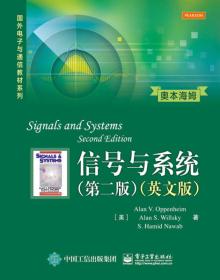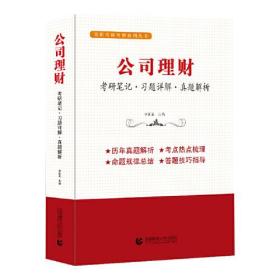
信号与系统(第二版 英文版)
正版二手,无赠品、光盘、MP3等。批量上传数据有误差,默认发一本,套装书需联系客服核实,还请见谅!
¥ 11.46 1.3折 ¥ 89 八五品
库存36件
作者[美]Alan V.(艾伦 V.奥本海姆)、Alan(艾伦 S.威尔斯基)、S.Hamid Nawab(S.哈米得 纳瓦卜) 著
出版社电子工业出版社
出版时间2015-04
版次1
装帧平装
货号9787121257278
上书时间2024-12-06
- 最新上架
商品详情
- 品相描述:八五品
图书标准信息
- 作者 [美]Alan V.(艾伦 V.奥本海姆)、Alan(艾伦 S.威尔斯基)、S.Hamid Nawab(S.哈米得 纳瓦卜) 著
- 出版社 电子工业出版社
- 出版时间 2015-04
- 版次 1
- ISBN 9787121257278
- 定价 89.00元
- 装帧 平装
- 开本 16开
- 纸张 胶版纸
- 页数 988页
- 正文语种 英语
- 原版书名 Signals and Systems
- 丛书 国外电子与通信教材系列
- 【内容简介】
-
《信号与系统(第二版 英文版)》是美国麻省理工学院(MIT)的经典教材之一,讨论了信号与系统分析的基本理论、基本分析方法及其应用。全书共分11章,主要讲述了线性系统的基本理论、信号与系统的基本概念、线性时不变系统、连续与离散信号的傅里叶表示、傅里叶变换以及时域和频域系统的分析方法等内容。《信号与系统(第二版 英文版)》作者使用了大量在滤波、采样、通信和反馈系统中的实例,并行讨论了连续系统、离散系统、时域系统和频域系统的分析方法,使读者能透彻地理解各种信号系统的分析方法并比较其异同。
- 【作者简介】
- 作者:Alan V. Oppenheim(艾伦 V. 奥本海姆),Alan S. Willsky(艾伦 S. 威尔斯基),S.Hamid Nawab(S.哈米得 纳瓦卜) 译者:无
- 【目录】
-
CONTENTS
1 SIGNALS AND SYSTEMS 1
1.0 Introduction 1
1.1 Continuous-Time and Discrete-Time Signals 1
1.1.1 Examples and Mathematical Representation 1
1.1.2 Signal Energy and Power 5
1.2 Transformations of the Independent Variable 7
1.2.1 Examples of Transformations of the Independent Variable 8
1.2.2 Periodic Signals 11
1.2.3 Even and Odd Signals 13
1.3 Exponential and Sinusoidal Signals 14
1.3.1 Continuous-Time Complex Exponential and Sinusoidal Signals 15
1.3.2 Discrete-Time Complex Exponential and Sinusoidal Signals 21
1.3.3 Periodicity Properties of Discrete-Time Complex Exponentials 25
1.4 The Unit Impulse and Unit Step Functions 30
1.4.1 The Discrete-Time Unit Impulse and Unit Step Sequences 30
1.4.2 The Continuous-Time Unit Step and Unit Impulse Functions 32
1.5 Continuous-Time and Discrete-Time Systems 38
1.5.1 Simple Examples of Systems 39
1.5.2 Interconnections of Systems 41
1.6 Basic System Properties 44
1.6.1 Systems with and without Memory 44
1.6.2 Invertibility and Inverse Systems 45
1.6.3 Causality 46
1.6.4 Stability 48
1.6.5 Time Invariance 50
1.6.6 Linearity 53
1.7 Summary 56
Problems 57
2 LINEAR TIME-INVARIANT SYSTEMS 74
2.0 Introduction 74
2.1 Discrete-Time LTI Systems: The Convolution Sum 75
2.1.1 The Representation of Discrete-Time Signals in Terms
of Impulses 75
2.1.2 The Discrete-Time Unit Impulse Response and the Convolution-Sum
Representation of LTI Systems 77
2.2 Continuous-Time LTI Systems: The Convolution Integral 90
2.2.1 The Representation of Continuous-Time Signals in Terms
of Impulses 90
2.2.2 The Continuous-Time Unit Impulse Response and the Convolution
Integral Representation of LTI Systems 94
2.3 Properties of Linear Time-invariant Systems 103
2.3.1 The Commutative Property 104
2.3.2 The Distributive Property 104
2.3.3 The Associative Property 107
2.3.4 LTI Systems with and without Memory 108
2.3.5 Invertibility of LTI Systems 109
2.3.6 Causality for LTI Systems 112
2.3.7 Stability for LTI Systems 113
2.3.8 The Unit Step Response of an LTI System 115
2.4 Causal LTI Systems Described by Differential and Difference
Equations 116
2.4.1 Linear Constant-Coefficient Differential Equations 117
2.4.2 Linear Constant-Coefficient Difference Equations 121
2.4.3 Block Diagram Representations of First-Order Systems Described
by Differential and Difference Equations 124
2.5 Singularity Functions 127
2.5.1 The Unit Impulse as an Idealized Short Pulse 128
2.5.2 Defining the Unit Impulse through Convolution 131
2.5.3 Unit Doublets and Other Singularity Functions 132
2.6 Summary 137
Problems 137
3 FOURIER SERIES REPRESENTATION OF PERIODIC SIGNALS 177
3.0 Introduction 177
3.1 A Historical Perspective 178
3.2 The Response of LTI Systems to Complex Exponentials 182
3.3 Fourier Series Representation of Continuous-Time
Periodic Signals 186
3.3.1 Linear Combinations of Harmonically Related Complex
Exponentials 186
3.3.2 Determination of the Fourier Series Representation
of a Continuous-Time Periodic Signal 190
3.4 Convergence of the Fourier Series 195
3.5 Properties of Continuous-Time Fourier Series 202
3.5.1 Linearity 202
3.5.2 Time Shifting 202
3.5.3 Time Reversal 203
3.5.4 Time Scaling 204
3.5.5 Multiplication 204
3.5.6 Conjugation and Conjugate Symmetry 204
3.5.7 Parseval's Relation for Continuous-Time Periodic Signals 205
3.5.8 Summary of Properties of the Continuous-Time Fourier Series 205
3.5.9 Examples 205
3.6 Fourier Series Representation of Discrete-Time
Periodic Signals 211
3.6.1 Linear Combinations of Harmonically Related Complex
Exponentials 211
3.6.2 Determination of the Fourier Series Representation of a
Periodic Signal 212
3.7 Properties of Discrete-Time Fourier Series 221
3.7.1 Multiplication 222
3.7.2 First Difference 222
3.7.3 Parseval's Relation for Discrete-Time Periodic Signals 223
3.7.4 Examples 223
3.8 Fourier Series and LTI Systems 226
3.9 Filtering 231
3.9.1 Frequency-Shaping Filters 232
3.9.2 Frequency-Selective Filters 236
3.10 Examples of Continuous-Time Filters Described by
Differential Equations 239
3.10.1 A Simple RC Lowpass Filter 239
3.10.2 A Simple RC Highpass Filter 241
3.11 Examples of Discrete-Time Filters Described by
Difference Equations 244
3.11.1 First-Order Recursive Discrete-Time Filters 244
3.11.2 Nonrecursive Discrete-Time Filters 245
3.12 Summary 249
Problems 250
4 THE CONTINUOUS-TIME FOURIER TRANSFORM 2,84
4.0 Introduction 284
4.1 Representation of Aperiodic Signals: The Continuous-Time
Fourier Transform 285
4.1.1 Development of the Fourier Transform Representation
of an Aperiodic.Signal 285
4.1.2 Convergence of Fourier Transforms 289
4.1.3 Examples of Continuous-Time Fourier Transforms 290
4.2 The Fourier Transform for Periodic Signals 296
4.3 Properties of the Continuous-Time Fourier Transform 300
4.3.1 Linearity 301
4.3.2 Time Shifting 301
4.3.3 Conjugation and Conjugate Symmetry 303
4.3.4 Differentiation and Integration 306
4.3.5 Time and Frequency Scaling 308
4.3.6 Duality 309
4.3.7 Parseval's Relation 312
4.4 The Convolution Property 314
4.4.1 Examples 317
4.5 The Multiplication Property 322
4.5.1 Frequency-Selective Filtering with Variable Center Frequenc) 325
4.6 Tables of Fourier Properties and of Basic Fourier
Transform Pairs 328
4.7 Systems Characterized by Linear Constant-Coefficient
Differential Equations 330
4.8 Summary 333
Problems 334
5 THE DISCRETE-TIME FOURIER TRANSFORM 358
5.0 Introduction 358
5.1 Representation of Aperiodic Signals: The Discrete-Time
Fourier Transform 359
5.1.1 Development of the Discrete-Time Fourier Transform 359
5.1.2 Examples of Discrete-Time Fourier Transforms 362
5.1.3 Convergence Issues Associated with the Discrete-Time Fourier
Transform 366
5.2 The Fourier Transform for Periodic Signals 367
5.3 Properties of the Discrete-Time Fourier Transform 372
5.3.1 Periodicity of the Discrete-Time Fourier Transform 373
5,3.2 Linearity of the Fourier Transform 373
5.3.3 Time Shifting and Frequency Shifting 373
5.3.4 Conjugation and Conjugate Symmetry 375
5.3.5 Differencing and Accumulation 375
5.3.6 Time Reversal 376
5.3.7 Time Expansion 377
5.3.8 Differentiation in Frequency 380
5.3.9 Parseval's Relation 380
5.4 The Convolution Property 382
5.4.1 Examples 383
5.5 The Multiplication Property 388
5.6 Tables of Fourier Transform Properties and Basic Fourier
Transform Pairs 390
5.7 Duality 390
5.7.1 Duality in the Discrete-Time Fourier Series 391
5.7.2 Duality between the Discrete-Time Fourier Transform ~md the
Continuous-Time Fourier Series 395
5.8 Systems Characterized by Linear Constant-Coefficient
Difference Equations 396
5.9 Summary 399
Problems 400
6 TIME AND FREQUENCY CHARACTERIZATION
OF SIGNALS AND SYSTEMS 423
6.0 Introduction 423
6.1 The Magnitude-Phase Representation of the Fourier
Transform 423
6.2 The Magnitude-Phase Representation of the Frequency Response
of LTI Systems 427
6.2.1 Linear and Nonlinear Phase 428
6.2.2 Group Delay 430
6.2.3 Log-Magnitude and Phase Plots 436
6.3 Time-Domain Properties of Ideal Frequency-Selective
Filters 439
6.4 Time-Domain and Frequency-Domain Aspects of Nonideal
Filters 444
6.5 First-Order and Second-Order Continuous-Time Systems 448
6.5.1 First-Order Continuous-Time Systems 448
6.5.2 Second-Order Continuous-Time Systems 451
6.5.3 Bode Plots for Rational Frequency Responses 456
6.6 First-Order and Second-Order Discrete-Time Systems 461
6.6.1 First-Order Discrete-Time Systems 461
6.6.2 Second-Order Discrete-Time Systems 465
6.7 Examples of Time- and Frequency-Domain Analysis
of Systems 472
6.7.1 Analysis of an Automobile Suspension System 473
6.7.2 Examples of Discrete-Time Nonrecursive Filters 476
6.8 Summary 482
Problems 483
7 SAMPLING 514
7.0 Introduction 514
7.1 Representation of a Continuous-Time Signal by Its Samples:
The Sampling Theorem 515
7.1.1 Impulse-Train Sampling 516
7.1.2 Sampling with a Zero-Order Hold 520
7.2 Reconstruction of a Signal from Its Samples Using
Interpolation 522
7.3 The Effect of Undersampling: Aliasing 527
7.4 Discrete-Time Processing of Continuous-Time Signals 534
7.4.1 Digital Differentiator 541
7.4.2 Half-Sample Delay 543
7.5 Sampling of Discrete-Time Signals 545
7.5.1 Impulse-Train Sampling 545
7.5.2 Discrete-Time Decimation and Interpolation 549
7.6 Summary 555
Problems 556
8 COMMUNICATION SYSTEMS 582
8.0 Introduction 582
8.1 Complex Exponential and Sinusoidal Amplitude Modulation 583
8.1.1 Amplitude Modulation with a Complex Exponential Car~ier 583
8.1.2 Amplitude Modulation with a Sinusoidal Carrier 585
8.2 Demodulation for Sinusoidal AM 587
8.2.1 Synchronous Demodulation 587
8.2.2 Asynchronous Demodulation 590
8.3 Frequency-Division Multiplexing 594
8.4 Single-Sideband Sinusoidal Amplitude Modulation 597
8.5 Amplitude Modulation with a Pulse-Train Carrier 601
8.5.1 Modulation of a Pulse-Train Carrier 601
8.5.2 Time-Division Multiplexing 604
8.6 Pulse-Amplitude Modulation 604
8.6.1 Pulse-Amplitude Modulated Signals 604
8.6.2 Intersymbol Interference in PAM Systems 607
8.6.3 Digital Pulse-Amplitude and Pulse-Code Modulation 610
8.7 Sinusoidal Frequency Modulation 611
8.7.1 Narrowband Frequency Modulation 613
8.7.2 Wideband Frequency Modulation 615
8.7.3 Periodic Square-Wave Modulating Signal 617
8.8 Discrete-Time Modulation 619
8.8.1 Discrete-Time Sinusoidal Amplitude Modulation 619
8.8.2 Discrete-Time Transmodulation 623
8.9 Summary' 623
Problems 625
9 THE LAPLACE TRANSFORM 654
9.0 Introduction 654
9.1 The Laplace Transform 655
9.2 The Region of Convergence for Laplace Transforms 662
9.3 The Inverse Laplace Transform 670
9.4 Geometric Evaluation of the Fourier Transform from the
Pole-Zero Plot 674
9.4.1 First-Order Systems 676
9.4.2 Second-Order Systems 677
9.4.3 AU-Pass Systems 681
9.5 Properties of the Laplace Transform 682
9.5.1 Linearity of the Laplace Transform 683
9.5.2 Time Shifting 684
9.5.3 Shifting in the s-Domain 685
9.5.4 Time Scaling 685
9.5.5 Conjugation 687
9.5.6 Convolution Property 687
9.5.7 Differentiation in the Time Domain 688
9.5.8 Differentiation in the s-Domain 688
9.5.9 Integration in the Time Domain 690
9.5.10 The Initial- and Final-Value Theorems 690
9.5.11 Table of Properties 691
9.6 Some Laplace Transform Pairs 692
9.7 Analysis and Characterization of LTI Systems Using the
Laplace Transform 693
9.7.1 Causality 693
9.7.2 Stability 695
9.7.3 LTI Systems Characterized by Linear Constant-Coefficient
Differential Equations 698
9.7.4 Examples Relating System Behavior to the System Function 701
9.7.5 Butterworth Filters 703
9.8 System Function Algebra and Block Diagram
Representations 706
9.8.1 System Functions for Interconnections of LTI Systems 707
9.8.2 Block Diagram Representations for Causal LTI Systems Described
by Differential Equations and Rational System Functions 708
9.9 The Unilateral Laplace Transform 714
9.9.1 Examples of Unilateral Laplace Transforms 714
9.9.2 Properties of the Unilateral Laplace Transform 716
9.9.3 Solving Differential Equations Using the Unilateral Laplace
Transform 719
9.10 Summary 720
Problems 721
10 THE Z-TRANSFORM 741
10.0 Introduction 741
10.1 The z-Transform 741
10.2 The Region of Convergence for the z-Transform 748
10.3 The Inverse z-Transform 757
10.4 Geometric Evaluation of the Fourier Transform from the
Pole-Zero Plot 763
10.4.1 First-Order Systems 763
10.4.2 Second-Order Systems 765
10.5 Properties of the z-Transform 767
1.0.5.1 Linearity 767
10.5.2 Time Shifting 767
10.5.3 Scaling in the z-Domain 768
10.5.4 Time Reversal 769
10.5.5 Time Expansion 769
10.5.6 Conjugation 770
10.5.7 The Convolution Property 770
10.5.8 Differentiation in the z-Domain 772
10.5.9 The Initial-Value Theorem 773
10.5.10 Summary of Properties 774
10.6 Some Common z-Transform Pairs 774
10.7 Analysis and Characterization of LTI Systems Using
z-Transforms 774
10.7.1 Causality 776
10.7.2 Stability 777
10.7.3 LTI Systems Characterized by Linear Constant-Coefficient
Difference Equations 779
10.7.4 Examples Relating System Behavior to the System Function 781
10.8 System Function Algebra and Block Diagram
Representations 783
10.8.1 System Functions for Interconnections of LTI Systems 784
10.8.2 Block Diagram Representations for Causal LTI Systems Described
by Difference Equations and Rational System Functions 784
10.9 The Unilateralz-Transform 789
10.9.1 Examples of Unilateral z-Transforms and Inverse Transforms 790
10.9.2 Properties of the Unilateral z-Transform 792
10.9.3 Solving Difference Equations Using the Unilateral
z-Transform 795
10.10 Summary 796
Problems 797
11 LINEAR FEEDBACK SYSTEMS 816
11.0 Introduction 816
11.1 Linear Feedback Systems 819
11.2 Some Applications and Consequences of Feedback 820
11.2.1 Inverse System Design 820
11.2.2 Compensation for Nonideal Elements 821
11.2.3 Stabilization of Unstable Systems 823
11.2.4 Sampled-Data Feedback Systems 826
11.2.5 Tracking Systems 828
11.2.6 Destabilization Caused by Feedback 830
11.3 Root-Locus Analysis of Linear Feedback Systems 832
11.3.1 An Introductory Example 833
11.3.2 Equation for the Closed-Loop Poles 834
11.3.3 The End Points of the Root Locus: The Closed-Loop Poles for
K = 0 and I|K|=+ 836
11.3.4 The Angle Criterion 836
11.3.5 Properties of the Root Locus 841
11.4 The Nyquist Stability Criterion 846
11.4.1 The Encirclement Property 847
11.4.2 The Nyquist Criterion for Continuous-Time LTI
Feedback Systems 850
11.4.3 The Nyquist Criterion for Discrete-Time LTI
Feedback Systems 856
11.5 Gain and Phase Margins 858
11.6 Summary 866
Problems 867
APPENDIX PARTIAL-FRACTION EXPANSION 909
BIBLIOGRAPHY 921
ANSWERS 931
INDEX 941
— 没有更多了 —












以下为对购买帮助不大的评价